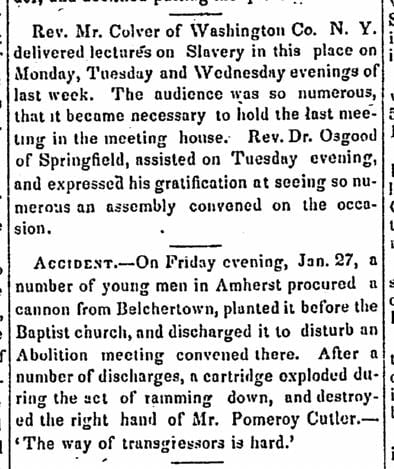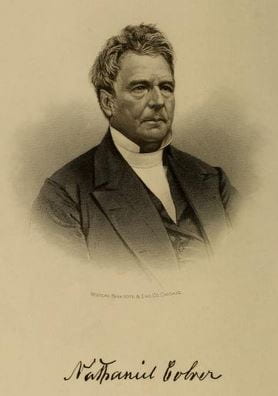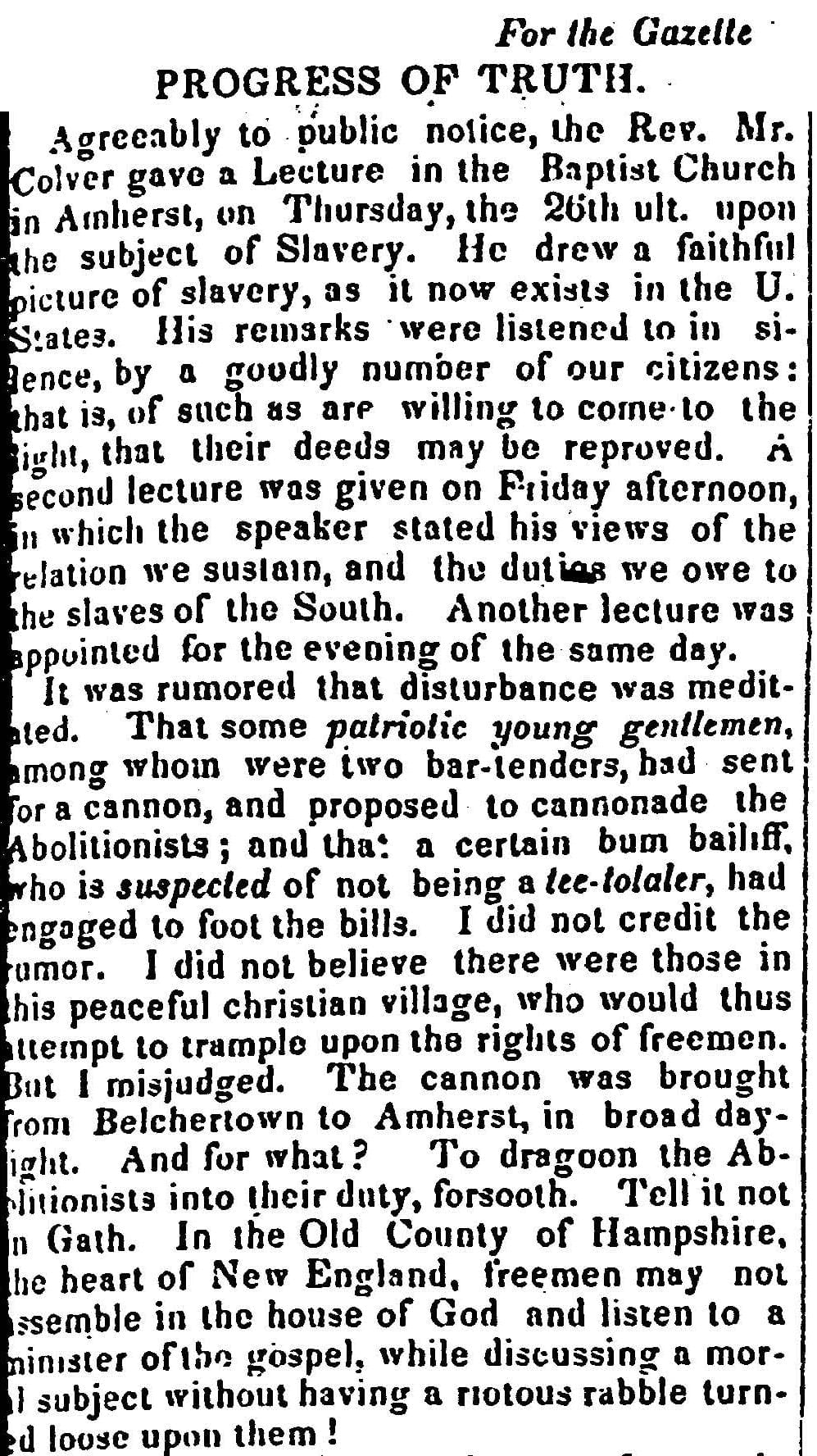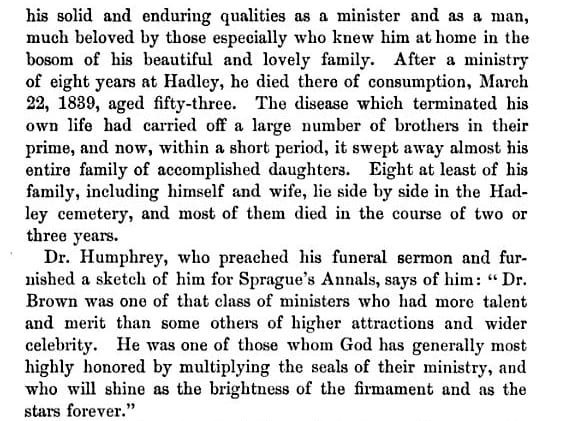An old letter is like a present. Its handwriting is the wrapping paper: before you can see or know the present, you have to unwrap it. The present may be inconsequential, something you’ll quickly forget. Or it might be something you keep, something you take with you, maybe even something that changes your life. But you’ll never know until you unwrap it.
Sometimes a present is for sharing, like the one-pound chocolate bar squirreled away in the desk drawer of your office. I recently unwrapped such a present –a letter full of delicious nuggets — and want to share it with you because it has lingered in my mind ever since I first read it.
 The letter is from William Seymour Tyler, Class of 1830, to his brother Wellington Hart Tyler, Class of 1831. The letter is dated January 30, 1837, when both men were in their mid-twenties. Wellington (apparently nicknamed “Edward”) was principal at an academy in Manlius, New York, while William was at Amherst College teaching Latin and Greek and heading into his glory days as the man whose tardiness inspired the founding of the Philopogonian Society. We often think of Edward Hitchcock, professor and president, as the emblem of early Amherst College, but Tyler was here just as long and served just as devotedly. His “History of Amherst College” continues to be a very valuable, reliable resource, and he was the author of other, more modest works, including the nicely named “Why Sit Ye Here Idle?”
The letter is from William Seymour Tyler, Class of 1830, to his brother Wellington Hart Tyler, Class of 1831. The letter is dated January 30, 1837, when both men were in their mid-twenties. Wellington (apparently nicknamed “Edward”) was principal at an academy in Manlius, New York, while William was at Amherst College teaching Latin and Greek and heading into his glory days as the man whose tardiness inspired the founding of the Philopogonian Society. We often think of Edward Hitchcock, professor and president, as the emblem of early Amherst College, but Tyler was here just as long and served just as devotedly. His “History of Amherst College” continues to be a very valuable, reliable resource, and he was the author of other, more modest works, including the nicely named “Why Sit Ye Here Idle?”
William Tyler’s letter to Wellington hits on a number of topics, including abolition in Massachusetts; the difficulty of finding money for Amherst College; the state of religious feeling at the College, and (my favorite part) about a certain family in Hadley. To look at it page by page (click on the original for an expanded view):
Above is a new lithograph of Buildings & Grounds, which are already familiar & welcome to your mind. The principle diff. between this & the former view consists in the new & elegant house of Esq, Boltwood & the terrace in front, which will soon be finished according to Esq. Wilder’s plan. In the Printer, you will recognize the name of a member of our senior class.”
[Transcriber’s note: the Boltwood house is off to the left, where Converse is now. “Esq. Wilder” is trustee Samson Vryling Stoddard Wilder. The “printer” is Henry G. Van Lennep, Class of 1837, born in Turkey and a missionary and avid amateur artist there for 30 years].
“ While on the subject of the college, I will inform you that the application of the Trustees for an appropriation of $50,000 is now pending before the legislature. The joint Committee of the two houses have reported unanimously in favor of the grant. We have not much hope of getting the bill through the house. Better for a literary man to run the gauntlet between as many Indians, than to fall into the hands of the 200 or 250 avowed & trained Radicals in the Mass House of Representatives. The Radicals are opposed in toto to incorporated Institutions. The Demagogues must court the favor of the people by voting for a distribution of the surplus revenue among the towns, though a majority of them doubtless are fully convinced that it will only embroil the people without benefitting them. And when the surplus is thus thrown away, the Legislature will hardly venture or feel disposed to tax the people for an appropriation to Amherst College. Still the prospect is much more favorable than at any former application.”
While on the subject of the college, I will inform you that the application of the Trustees for an appropriation of $50,000 is now pending before the legislature. The joint Committee of the two houses have reported unanimously in favor of the grant. We have not much hope of getting the bill through the house. Better for a literary man to run the gauntlet between as many Indians, than to fall into the hands of the 200 or 250 avowed & trained Radicals in the Mass House of Representatives. The Radicals are opposed in toto to incorporated Institutions. The Demagogues must court the favor of the people by voting for a distribution of the surplus revenue among the towns, though a majority of them doubtless are fully convinced that it will only embroil the people without benefitting them. And when the surplus is thus thrown away, the Legislature will hardly venture or feel disposed to tax the people for an appropriation to Amherst College. Still the prospect is much more favorable than at any former application.”
[By the time of this letter, Amherst had its hard-won charter but was about to enter a period of financial difficulties and was seeking additional funding from the state.]
“There have been during the past term & vacation four or five hopeful conversions among students, chiefly the freshman class. Rather more feeling, I think, now than last term.
The junior class received a valuable accession in a young man by the name of Smith from Yale College. He has more talents & is a more elegant scholar than Maynard. If he exerts himself, he will carry off the palm. You are probably impatient about the colloquia. When I wrote you last term, I had not explored the archives. On examination, I could not find either of the colloquies I wished or any other I ever heard on the stage. I found three or four, which I have not examined. If they are of any value, or will answer, I shall get a couple of them copied for you. Possibly more may be discovered, as the Archives have been thrown into confusion by the President’s moving. If not, might you not venture to write [Haven?] at the Asylum in New York, requesting him to send you a copy of his Colloquy, offering of course to remunerate him?”
[Tyler writes above about the state of religious feeling at Amherst, especially in relation to the revivals that swept through the area. He refers as well to Class of 1838 members Charles Fuller Smith and Horace Maynard, both of whom had important careers in politics and the law. Note too that by this time President Heman Humphrey had moved from the “first president’s house” (in the block where Mayo-Smith is now) to the house we still use as the president’s house today. It’s also interesting that Tyler is already thinking in terms of “archives” — good man, that Tyler. By “colloquia,” Tyler probably refers to records of religious debates or discussions.]
 “The two Sisters ha! It seems I have kept you on tiptoe a month to know who they are. One of them is more likely to be wedded to the worm, than to me. She is probably near her end. She is a bright jewel. But the younger sister is brighter, sweeter still. She is perfectly enchanting tout ensemble form, features, mind, heart. Edward, if you can’t love Miss Nancy Brown of Hadley—nay, if you can help loving her on acquaintance, you are not my brother– ”
“The two Sisters ha! It seems I have kept you on tiptoe a month to know who they are. One of them is more likely to be wedded to the worm, than to me. She is probably near her end. She is a bright jewel. But the younger sister is brighter, sweeter still. She is perfectly enchanting tout ensemble form, features, mind, heart. Edward, if you can’t love Miss Nancy Brown of Hadley—nay, if you can help loving her on acquaintance, you are not my brother– ”
[More on this part below…]
[Letter addressed in this space to “Mr. W. H. Tyler, Manlius, Onondaga Co, N.Y.]

We’ve had an anti-slavery fraternite [sic] meeting in the [Baptist Church] lately. In firing Cannon to disturb the Lecturer one Evening, a young man had his hand blown entirely off. That gun was a loud Lecture. Write soon. Yours, Wm. Tyler
This brief part of the letter is important for its depiction of the uncertain state of abolitionist sentiment at the time, both among students and faculty at the College and among the townspeople. The speaker on this occasion was Rev. Nathaniel Colver, who preached against slavery for many decades and who by this time was probably inured to whatever insults the opposing side would hurl (or fire) at him.
Tyler seems to have been sympathetic to the cause, probably agreeing with the author of an op-ed in the Hampshire Gazette that describes the event:
My favorite part of Tyler’s letter, though, is where he writes about the Brown family and uses that spectacular expression, “wedded to the worm.” Did he coin that expression? Surely not, but I have yet to find it anywhere else except in a few articles and one poem (appended at end of post), all dated after Tyler’s letter.* Tyler’s comments about the Browns piqued my curiosity, and if you suffer as I do from even a minor case of obsessive compulsion, you will not rest (so to speak) until you know who Nancy Brown is. But what are the chances? “Nancy Brown” sounds like a pretty common name. And she probably married and changed it, so good luck to me.
To my surprise, the family turned up quickly. And then I found a section in Tyler’s “History,” published more than 35 years after his letter to Wellington, that confirmed the identification and revealed a tragic tale. Tyler’s remembrance of the “beautiful and lovely family” and the “accomplished daughters” is downright sentimental, so you can tell the doomed family meant a lot to him:
For the purposes of this post, the point in the article above is that the Browns were a family of consumptives across at least two generations. One by one the Browns died of tuberculosis: among the family members Tyler knew, one each died in 1837 and 1838, four in 1839, and one each in 1840 and 1842. Their home and worldly belongings were sold bit by bit too.
And the horrid cherry on top?? The beds and bedding went up for sale.
Who wants first dibs on the beds from a family of consumptives? You call it? Be my guest.
![Cristobal Rojas [Public domain], via Wikimedia Commons. https://commons.wikimedia.org/wiki/File%3ACristobal_Rojas_37a.JPG Cristobal_Rojas_37a-viawikipedia](https://consecratedeminence.wordpress.amherst.edu/files/2015/10/cristobal_rojas_37a-viawikipedia.jpg?w=500)

I went to find the Browns in nearby Hadley. And there they were, all lined up. I was glad to find them – glad to see them — and it felt like they were glad of company, some of them a little tipsy in excitement. But it was also sad to see this evidence of a family wiped out in half a dozen years.

So when Tyler referred to the Brown daughter about to be wedded to the worm, he most likely meant Lucy Ann, who died on February 2, only a few days after Tyler wrote his letter:
Unfortunately, and as you can see from the caption in the group photograph above, the perfectly enchanting Miss Nancy Brown also succumbed to the disease.
After most of her family had died, Nancy left her sad home in Hadley to live with relatives in Vermont. She made provisions so that when she too died, her body would be returned to Hadley to lie with her family.

Nancy’s obituary mentions one last daughter. It took a while to find her, but I finally learned that little Helen A. Brown, born in 1834, went to live with a colleague of her father’s, Rev. Joseph Day Condit. Helen too eventually died of tuberculosis in 1855 at the age of 21. This last daughter of Rev. John Brown lies with her adopted family in South Hadley, Mass.
William Tyler must’ve known Nancy Brown was doomed because he didn’t marry her when he could’ve. Instead, he married the bonny Amelia Whiting, who lived to be 85 and with whom he had five children.
William S. Tyler’s letter has a lot of useful information about early Amherst College, but the unfortunate Browns of Hadley continue to rattle around in my thoughts and to visit me in quiet times.
*************************************************

*****************
*2022 update: Sue Anderson, a friend and fellow researcher, discovered what may have been Tyler’s source for the expression “wedded to the worm” in a poem published via the Hathi Trust in “The Letter-Box,” volume 5. It exactly suits Tyler’s feelings about the Brown daughters:














